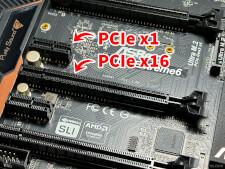PCI Express
Stands for "Peripheral Component Interconnect Express," and is abbreviated "PCIe" or "PCI-e."
PCI Express is the standard expansion bus on modern computer motherboards. It replaced several previous standards, including PCI and AGP. Most computer motherboards include a set of PCIe expansion slots allowing users to install expansion cards to add new and improved computer capabilities.
PCIe slots are available in four sizes — x1, x4, x8, and x16 — based on how many individual PCIe lanes run to and from that slot. A PCIe x1 slot is the smallest and slowest, using a single PCIe lane; a PCIe x4 slot uses four PCIe lanes at once and thus has four times the total bandwidth. Each size slot is longer than the previous size and can accept cards designed for the smaller types. For example, an x1 card can fit into any size PCIe slot, while an x8 card can fit into an x8 or x16 slot but not an x1 or x4.
Updated versions of the PCIe bus are introduced every few years, with each new PCIe version capable of data transfer rates roughly twice as fast as its predecessor. For example, PCIe version 1.0 transfers data at 250 MB/s per lane, version 2.0 at 500 MB/s per lane, and 3.0 at 1 GB/s per lane. The slot size and arrangement do not change between generations, and any PCIe card works in a slot that it fits into at the slower version's speed. Therefore, a PCI 4.0 x16 graphics card works in a PCI 3.0 x16 slot but at half of its designed bandwidth. As of 2023, the most recent PCIe version is 6.0, which transfers data at 7.5 GB/s per lane (up to 121 GB/s at x16).
NOTE: Other interfaces can use the PCIe bus to transfer data, like the M.2 slot used by NVMe SSD drives.
 Test Your Knowledge
Test Your Knowledge